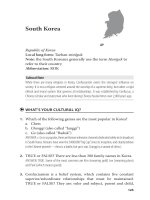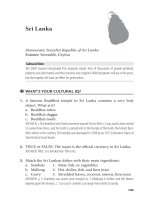Life skill how to do almost anything
Bạn đang xem bản rút gọn của tài liệu. Xem và tải ngay bản đầy đủ của tài liệu tại đây (14.68 MB, 201 trang )
ManteshLIFE SKILLS
How to Do Almost Anything
Chicago Tribune Staff
Copyright 2012 by the Chicago Tribune.
All rights reserved. No part of this book may be reproduced or transmitted in any form or by any means, electronic or mechanical,
including copying, recording, or by any information storage and retrieval system, without express written permission from the publisher.
Chicago Tribune
Tony W. Hunter, Publisher
Vince Casanova, President
Gerould W. Kern, Editor
R. Bruce Dold, Editorial Page Editor
Bill Adee, Vice President/Digital
Jane Hirt, Managing Editor
Joycelyn Winnecke, Associate Editor
Peter Kendall, Deputy Managing Editor
Ebook edition 1.0 June 2012
ISBN-10 1-57284-420-5
ISBN-13 978-1-57284-420-9
Agate Digital is an imprint of Agate Publishing. Agate books are available in bulk at discount prices. For more information visit
agatepublishing.com.
TABLE OF CONTENTS
About This Book
BASICS
Arrange Flowers
Clean a Bathroom
Clean the Refrigerator
Cut Your Own Hair
Decode Nutritional Labels
Hang a Painting
Iron a Shirt
Make a Good Sign
Pick Fruit
Plant a Tree
Polish Your Nails
Repot a Houseplant
Sew a Button
Shine Leather Shoes
Snuff a Kitchen Fire
Tie a Bow Tie
Wash a Dog
Wash a Window
Wash a Wine Glass
Wrap a Gift
AT THE OFFICE
Ask for a Raise
Clean a Computer Keyboard
Clean Your Desk
DIY Facial Massage
PLAY
Avoid Dog Bites
Mantesh's ebooksdownloadrace.blogspot.in
Babysit a 1-Year-Old
Bowl Without Hurting Anyone
Grab a Cab
Keep Score at the Ballpark
Make Outfield Grass Patterns at Home
Pack for Road Trips
Photograph a Dog
Prepare an Evacuation Kit
Summer First Aid for Kids
Teach Bike Riding
TECHNICAL
Change a Tire
Critical Car Checks
Display the American flag
Fix a Leaky Faucet
Jump Start a Car Battery
Load a Truck on Moving Day
Make Campfire Without Matches
Smarter Lawn Mowing
Take/Throw a Punch
Unclog a Bathroom Drain
SOCIAL
Apologize
Ask for a Favor
Be a Good Witness to a Crime
Break the Ice
Choose an Engagement Ring
Door Etiquette
Drive in a Funeral
End a Relationship
Flirting
Get Your Foot in the Door
Give a Wedding Toast
Mantesh ebooksdownloadrace.blogspot.in
Have a Tough Conversation
Picking Up the Check
Someone’s Fly is Down
The Social Kiss
Tip for Services
Turn Down a Request
CREDITS
About This Book
This book is a collection of the Chicago Tribune’s popular feature, “Life Skills,” a step-by-step guide
to practical and whimsical everyday tasks.
BASICS
Arrange Flowers
Before launching her fearlessflowers.com, Annie Vanderwarker commissioned a survey. It
found that 68 percent of people who bought cut flowers at the grocery store were afraid to arrange
them. “They just plunk them in something without even trying to arrange them,” she says. But with a
little forethought and effort, a merely adequate arrangement can become a real eye-catcher. And
Vanderwarker is willing to help.
Step #1: Planning
Before you snip your first stem, think it out. What is this arrangement for and where is it going?
If it’s a centerpiece at a dinner table: Don’t exceed 12 inches in height; you don’t want guests
having to peer through a jungle to see the person across the table. If the arrangement will sit against a
wall, flowers face outward, in one direction. No need to put on a 360-degree show.
First, choose between glass and ceramic. If you’re worried about how your stems will look and
don’t want to incorporate them in the finished work, go ceramic. There are vases in every size and
shape. If you’re worried your flowers won’t stand at attention, create a grid across the top of the vase
using tape (florist’s tape or even scotch tape will work).
Selecting
If you’re cutting your own, do it early in the morning because they don’t like to be cut during the
heat of the day. But flowers from a grocery store’s floral department — this is what most people have
easy access to, Vanderwarker points out — will work just fine. There is a huge variety to choose
from. The most popular are roses, carnations, tulips and gerbera daisies, she says. And you don’t
need a lot; An attractive arrangement can be made with three to five flowers.
For an interesting change, there are some flowers that do well underwater and can last more than
a week. Hydrangea, tulips, orchids and anything else with a kind of a waxy surface will work.
Making it more interesting: The flowers get magnified by the glass container.
Flowers that last longer include alstroemeria, tulips and sunflowers. Two points to remember:
Tulips will continue to grow after you’ve put them in a container, and you can eliminate the
awkwardness of tall sunflowers – everybody loves them but not everyone knows how to make them
look good — by cutting the stems or by weaving them together.
As for colors, it’s up to you.
Cutting
Trim an inch or two off every stem with a clean cut. If it’s a woody stem — hydrangea, for
example — split the stem at the bottom. It’ll help the absorption of water.
Vanderwarker suggests some overnight prep work on the garbera daisies. She puts a baker’s
cooling rack over a bucket of water and stands the daisies in the water, up to their necks. The
additional water pulled up by the flower will make it stand up better.
Step #4: Arranging
If it’s a tight arrangement or if you’ve got a tape grid across the top, put the water — room
temperature — in the vase first. If it’s a loose arrangement, the water can go in afterward.
“I usually try to add flower food, the one that comes one prepackaged at the grocery store,”
Vanderwarker says, “or a couple of drops of bleach.” (Bleach kills bacteria, which can inhibit the
flowers’ absorption of water.)
Strip any leaves that would be underwater; they’d just rot and foul the water.
Don’t be afraid to shorten the flowers. Many vases are v-shaped to take advantage of a big
bunch of flowers. But if the flowers are tall, they can spread over and flop over. Vanderwarker
prefers square and rectangular containers. Also remember: The closer the heads are to the edge of the
container, the fewer flowers you’ll need. So shorten them up.
It usually doesn’t matter what order to place the flowers in the vase. “If I’m using (a lot of)
flowers, usually I take the ones that have the woodiest stems or ones with the most support structure
first (so) I can balance the others with them.”
Clean a Bathroom
It’s a dirty job — but someone’s got to clean the bathroom. And when it’s you, what’s the most
efficient way?
Since most materials used in bathrooms are easy to clean, give it a quick wipe daily, experts
advise. Tackle a full clean once a week.
“Frequent cleanings mean less work because there will not be weeks of crud to clean,” says
Cathy Faulcon Bowen, a professor with Pennsylvania State University’s department of agricultural
and extension education. “If you have a single bathroom and many users, the bathroom might need to
be cleaned more often.”
Degree of difficulty: Easy. Less elbow grease than hand-washing your car.
Time: 5 minutes daily; 30 minutes once a week
Tools: Cloth or sponge, rubber gloves, all-purpose cleaner*, baking soda, glass cleaner, long-
handled toilet bowl brush, bucket
DAILY
Rinse out sink, bathtub and shower stall after each use.
Remove excess hair from sink or tub.
Flush toilet after each use.
Hang up towels and washcloths.
Remove dirty clothes.
WEEKLY
Step 1: Everything but the toilet
Swab sink/tub/shower stall. Wash these areas with a soapy cloth or sponge and all-purpose
cleaner; rinse with clear water.
Clean the space behind water faucet controls and backsplash: Soap scum can accumulate at
fixtures’ edges. “To clean this tight area well, you usually have to use an old toothbrush,” Bowen
says.
Cleaning tip: Use baking soda and wet sponge to clean scum or stubborn marks; rinse with clear
water.
Most plastic shower curtains can be machine-washed with a load of towels (check the tag).
Hang wet shower curtain in the bathroom to air dry.
Shine mirror with glass cleaner.
Clean the Refrigerator
they should be. “The refrigerator is a spot in the house where it’s easy to accumulate stuff,” says
Carolyn Forte, director of home appliances and cleaning products at the Good Housekeeping
Research Institute. “People put things in. You go to a restaurant, and you get takeout; you shove that
in. Things have a way of working their way to the back and never coming out again.” Here’s Forte’s
approach to cleaning:
Needed: 30 minutes, hot water, liquid dish detergent, sponge, soft cloths or paper towels for
drying. “You really don’t need any strong chemical cleaners; you don’t need any tough abrasive tools
or sponges.”
Step 1
Clean out the refrigerator. “Get rid of old food you’re not going to use, things way past their
prime,” says Forte. Wipe drips and condensation off jars and bottles.
Step 2
Do one shelf at a time; temporarily move items to another shelf. Tackling the whole thing? Move
items to a counter. If cleaning takes longer than 30 minutes (it shouldn’t), consider using a cooler.
Step 3
Mix hot water and dishwashing liquid in the sink. Start with the main shelves; they’re generally
removable, so take them out and put them in the dishwater. Wash, rinse, dry and put back. Can’t
remove them? Wash with a soft cloth or sponge and soapy water, rinse and wipe dry.
Step 4
Bins generally come out; wash, rinse, dry and put back. Check and clean places that collect
drips: behind and under the bins. Pull out drawers; check the runners of the drawers. Wipe bins on the
door.
Step 5
“It’s a good thing to give the gasket around the door a cleaning with the soap and water,” says
Forte. “You want to make sure nothing grows in the crevices. You don’t want any mold in there.”
Step 6
Cover food well and return to refrigerator. Since “air circulates between the refrigerator and the
freezer, sometimes if your ice smells, it’s because food is not covered well.”
Step 7
Wipe down the exterior using all-purpose cleaner (or a stainless steel cleaner for a stainless
steel refrigerator). Pay attention to the handles. Clean the top of the refrigerator (if it’s not built in), a
magnet for greasy soil.
Step 8
Vacuum out dust or use a brush to clean the coils according to your manual (many refrigerator
manuals are now online). If you have an ice and water dispenser, make sure you change filter.
TIPS:
Gunk: If anything’s stuck on, rinse a cloth in really hot water, lay it on that stuck-on residue for
a while; that generally softens it, and you can remove it.
Bins: Consider lining bins with a paper towel. “If the lettuce gets wilted or something gets
moldy, just toss it away,” says Forte. Replace with a fresh one to help things stay clean.
Clean: For more cleaning tips, check out Good Housekeeping’s iPhone app, Good
Housekeeping @Home App
Toss: For guidelines, go to stilltasty.com
Cut Your Own Hair
Although it’s best to leave the pixie cut or layered bob to the pros, amateurs can perform a basic
trim if they need to save on a salon visit or cannot tolerate their split ends one moment longer. Elena
De Vera, master stylist at Avant Garde Salon and Spa in Miami, offered tips for trimming your
tresses.
Degree of difficulty: Medium. (If you’ve never done this, it requires a certain level of bravado.
But remember: Your hair will grow back.)
Tools you’ll need: Comb; sharp scissors; clean, dry hair — only the pros should cut hair when
wet.
To trim dead ends or overall length
Part your hair down the middle, and bring each side forward as though you’re making pigtails.
Brush one side evenly and thoroughly with a comb, and stretch it until it’s taut.
Slide your middle and index fingers to where you wish to cut, keeping all the hair from the back
between your fingers, and cut straight across, just underneath your fingers. Then do the other side.
To trim front layers (for long layers — cutting short layers is too easy to mess up)
With hair parted in the middle, comb the shortest layer out and hold it in front of your face
between your middle and index finger. Following the line that already exists, snip toward the hair, so
that the point of the scissors is facing the ends. Do half an inch to start; you can always cut more if it
isn’t enough. Do the next shortest layer, and so on.
Note: Cutting hair while it’s parted in the middle gives you the most flexibility for styling, but
you can cut it at your regular part if you know you’ll always wear it that way.
To trim bangs
Comb bangs out, grasp them in your hand and twist them once or twice. With scissors pointing
up, cut into the hairs vertically just under your eyebrow line for a soft, wispy bang.









